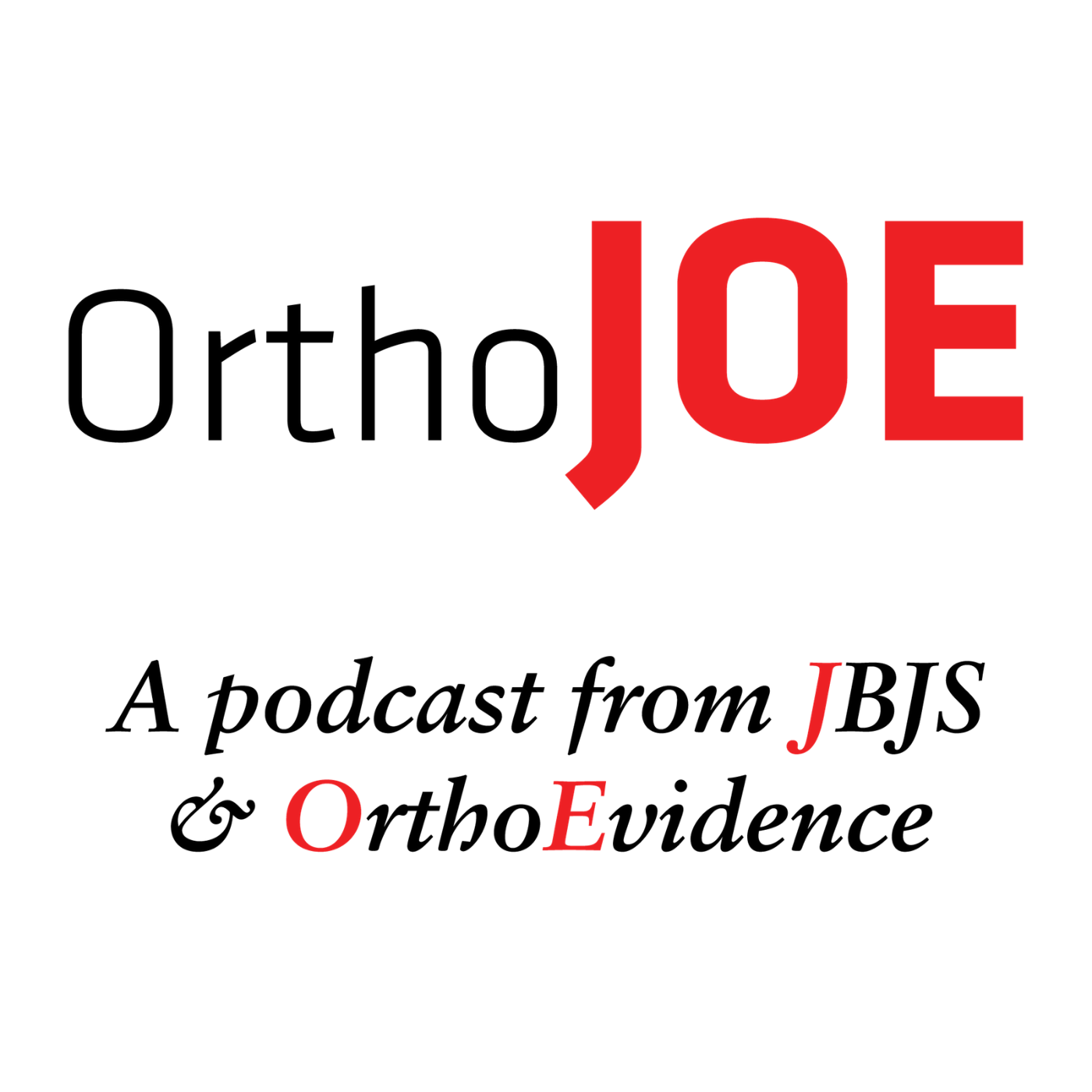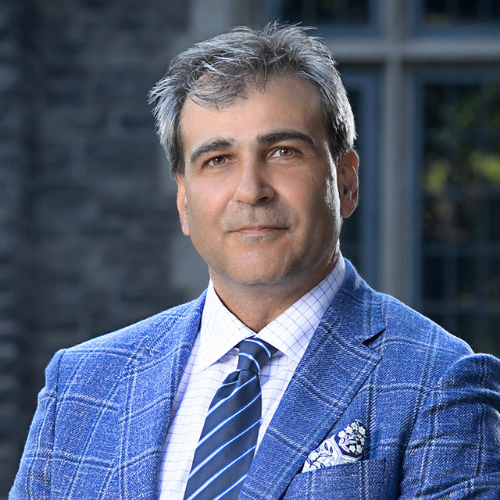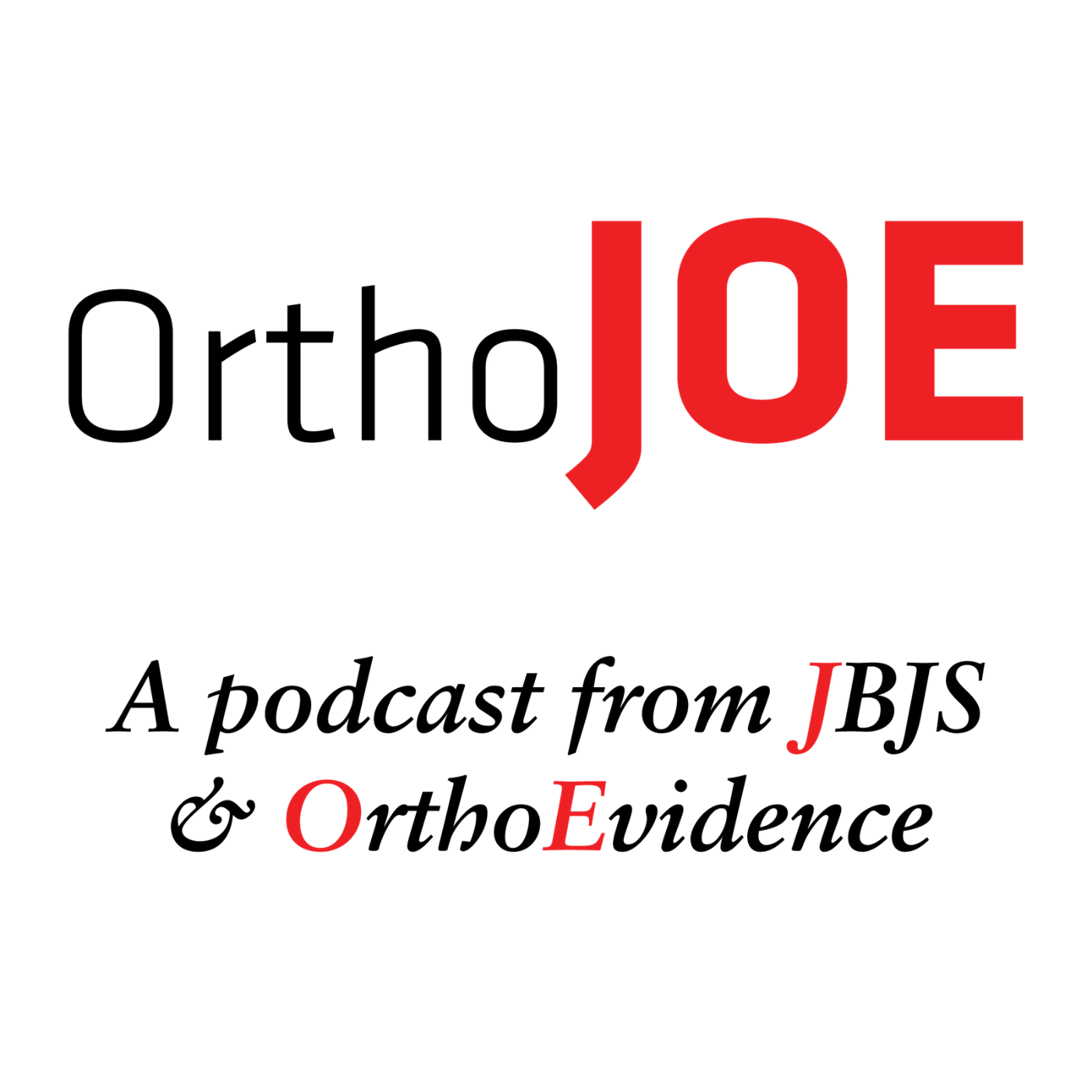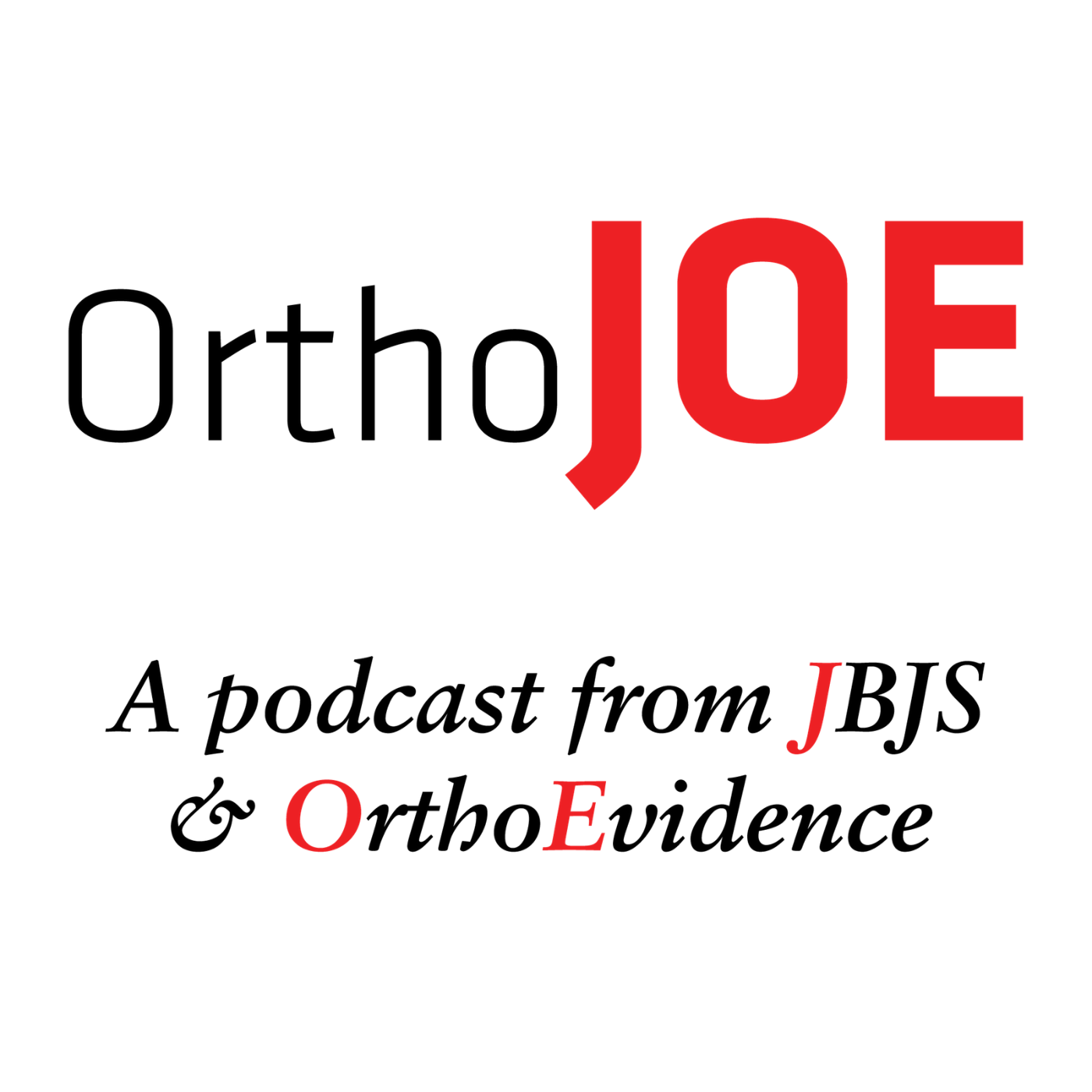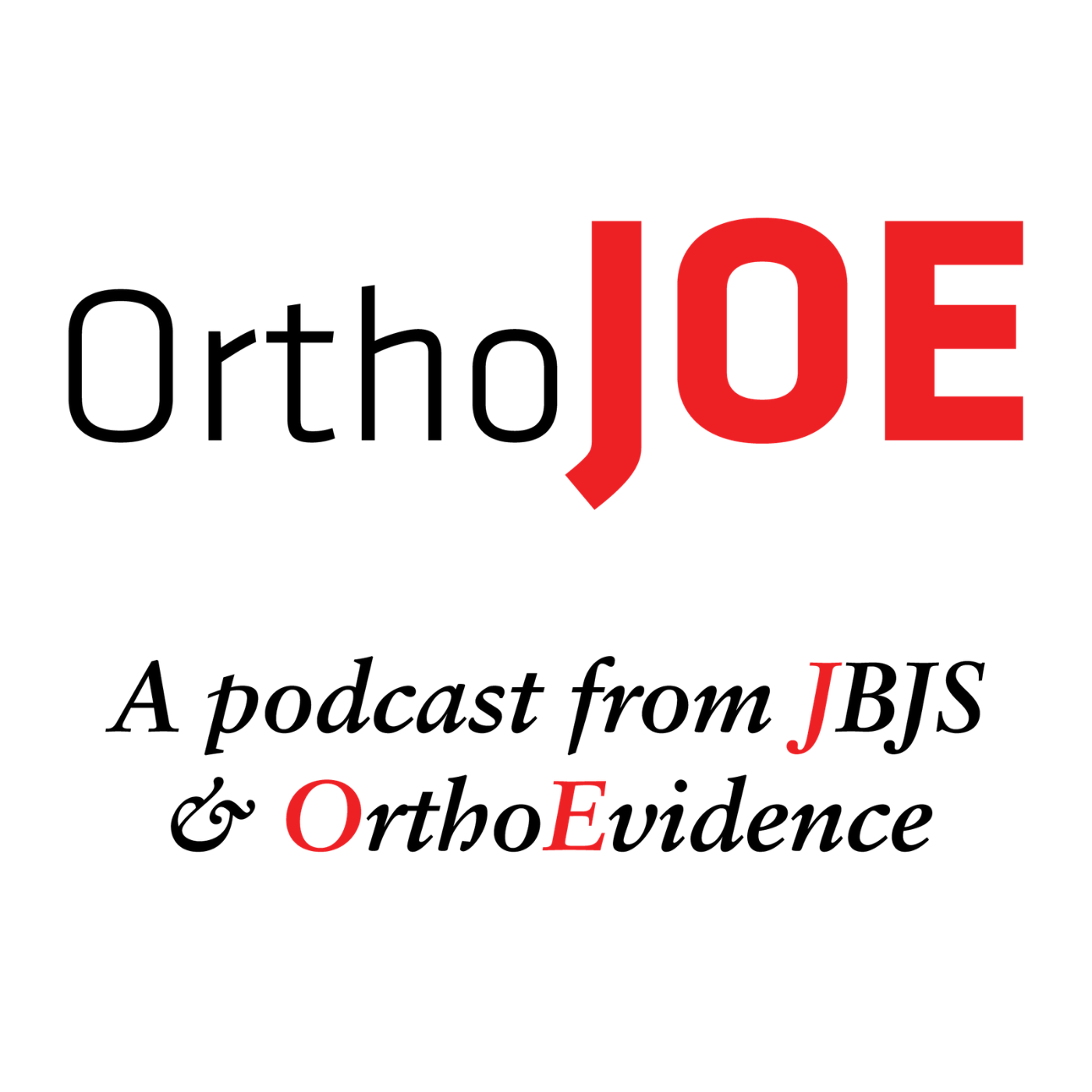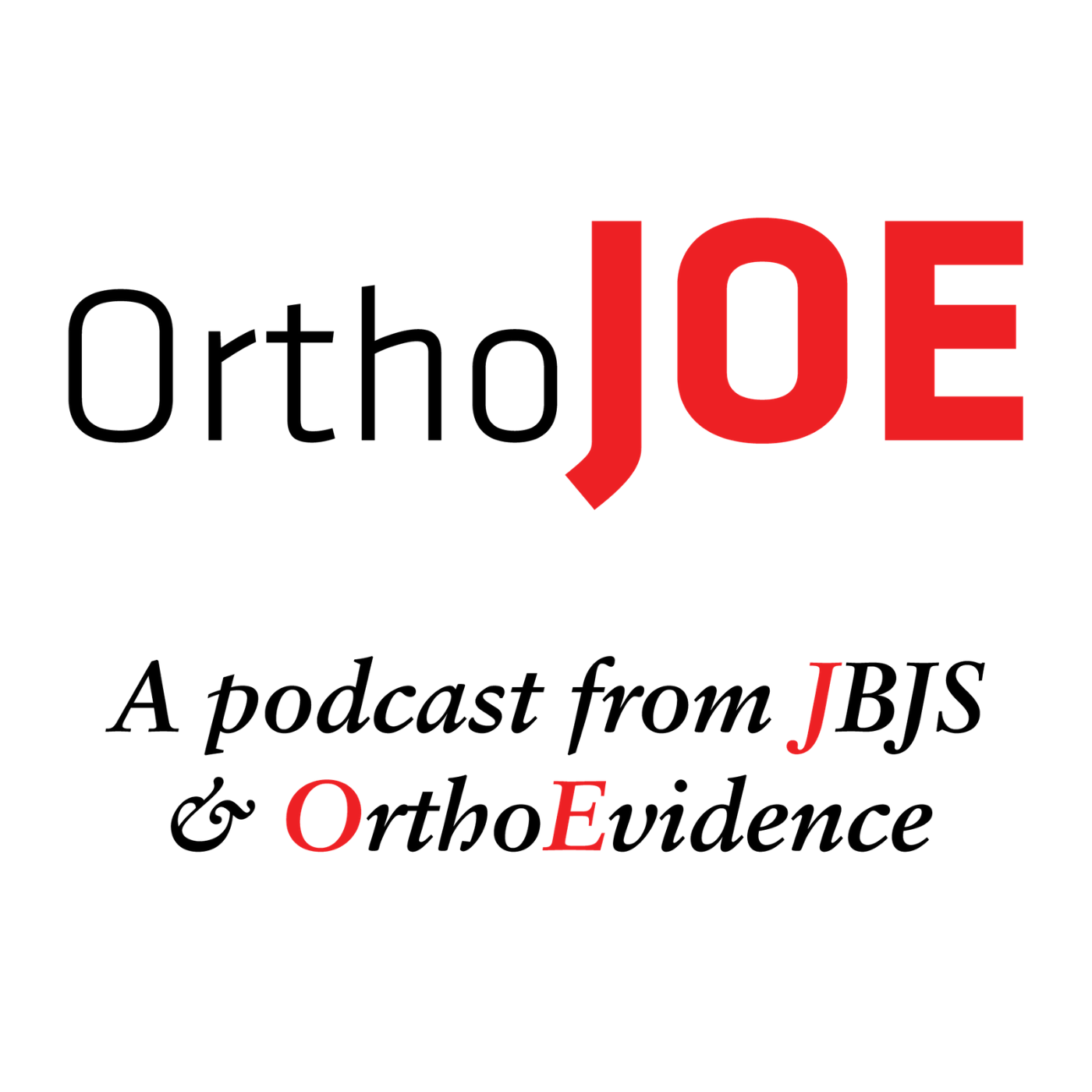Episode Transcript
[00:00:03] Speaker A: Welcome to the Ortho Joe Podcast, a joint production of the Journal of Bone and Joint Surgery and Ortho Evidence.
Join hosts Mohit Bhandari and Mark Swankowski as they discuss current topics and publications.
[00:00:15] Speaker B: In the world of orthopedics and beyond.
[00:00:19] Speaker C: Well, good morning, Mark. We are here again on another. Well, at least in Canada, it's a sunny Tuesday morning. How's it for you?
[00:00:27] Speaker A: Oh, it's great. And I'm wondering if you've got your Tim Hortons.
[00:00:30] Speaker C: I. You know what? I do not have it. I had a very early drive in around 5 this morning and didn't stop by, so I'm. I've come in just for this, but I'm gonna get one after.
[00:00:40] Speaker A: Okay. Well, I've got.
So I've got this mug which I determined this morning that you have to drink in the left, in my case, non dominant hand.
And it's a very expensive mug that costs somewhere around $2,000 a year to the university. So it's priceless. And I have a nice latte in it and I'm getting ready to go for the day.
[00:01:07] Speaker C: I love it. I love it. Well, listen, we have a pretty interesting guest with us. Dr. Sagar Desai, who is a foot and ankle surgeon in the Toronto area, has done a ton of, I would say, I think it's fair to say, social media broadly, but he really covers a broad area of topics in the area of foot and ankle surger. And particularly I was intrigued by one of his posts on why are we seeing so many Achilles tendon ruptures in sports in particular? I think this is related to basketball. First of all, welcome, Sagar, and thank you so much for participating today.
Let me ask.
[00:01:43] Speaker B: Thank you for having me.
[00:01:44] Speaker C: Yeah. Let me just ask you upright. So why are we seeing so many Achilles tendon ruptures? What's going on?
[00:01:49] Speaker B: That's a very tough question.
We're seeing a lot. And I think one thing is important to see is we.
We tend to get, you know, in social media, we see the big guys, right? We see Tyrese Halliburton, Jason Tatum. When these things happen to these major athletes on major stages, particularly with Halliburton on game seven, the topic becomes hot for a while, then it cools down. And if you really look into it closely, it's not just these guys having these NBA players, it's really this massive increase over the last number of decades. If you look at Swedish databases, various different European databases, Canadian studies, American studies, everything is showing not only an increase over the years, But a quite massive increase.
We're talking from 2000 to now, we're talking 50% in some cases even more.
There's a massive number that's not just on tv. This is proven in every single study possible to date in pretty much all over the world.
So we're seeing a huge increase. And what's interesting, we're seeing an increase at pretty much every level from teenagers to 80 year olds and everyone in between. So I believe there's probably different reasons for all those, but we are seeing a massive number overall over the last number of decades and years.
[00:03:02] Speaker A: So let's hear the theories. Young versus old. Let's just start with that.
[00:03:06] Speaker B: Yeah, so I kind of, at least when I in my practice, so as an orthopedic surgeon, I have somehow become the Achilles guy in this area, in this country. So I'll see anywhere from on minimum 2, 3, 4 a week, sometimes up to 10 fresh ruptures a week. So I see a huge volume. Wow. So what I've noticed in my own practice is probably reflected in the literature and everywhere else. And what I've seen is actually quite simple. I see a higher number of young people, twenties and younger teenagers. I see a higher number of pro athletes.
I see a higher number of the classic guys like you. And I like the middle age weekend warrior, which is the classic Hillary doctor like this is the 40 to 60, I see it a huge increase in the older athlete, older than 60, older than 70, older than 80. And I do see in general my practicing more women as opposed to men. I see you look at five different categories and I believe there's similarities with all of them, but also major differences. So if you want to start with kind of the older athlete, without question, there's two major reasons. One is that I believe older patients, when I say older, older, 40, 50, 60, are participating more in activities, being more active, playing more sports, which is obviously great, but they're also choosing sports that have a higher risk of injury. And obviously pickleball is without question the biggest change in my practice over the past five years in that age group. It's more participation, participation in riskier activities. And specifically I've seen an increase, a massive increase in, you know, pickleball injuries specifically. And, and give an example. On one day I once saw four fresh ruptures from pickleball alone in one single day. So that's the main kind of trend I'm seeing in the older athlete.
Wow.
[00:04:50] Speaker A: Well, keep going, keep going. Right down the line.
[00:04:53] Speaker B: So, yeah, so that's the Older athlete. And you want to go the other extreme, the younger athlete. I'm seeing teenagers, you know, frequently now. And there are a lot of theories. To me, the, the most, probably most relevant theory, what I've seen is, and not accusatory, I always ask the parents and the kid out of curiosity, what sport do you play? What sports have you been playing? What have you done? When I was younger, I'm in my 40s now, when I was younger and probably similar, and I'll speak for both Bo and Mark, but I played hockey, baseball, basketball, soccer, swam, tennis. I played every sport, two, three months a year. It wasn't like I played one sport.
Now for multiple reasons, a lot of it, which is probably social media and you know, driven by these massive contracts with pro athletes, I believe younger people are now playing a single sport. More often.
Basketball, you know, accounts for about 50 of Achilles injuries. So basketball in particular, the young guys I'm seeing, you know, they start playing basketball when they're six years old. You see a lot of NBA players criticize the AAU circuit because they're playing when they're six years old, seven years or eight years old, playing three games a day, 12 months a year.
So now you're basically putting stress on a young body, on the Same hard surface 12 months a year instead of mixing things up a little bit. And I believe in that younger patient population.
To me, that's probably the biggest thing I'm seeing in terms of incidence of ruptures is just based on the single sport specialization.
[00:06:14] Speaker C: Okay. So that covers the very young and the elderly. The athlete.
[00:06:19] Speaker B: Yeah. So let's just talk about basketball because that's the big hot topic. Right. So many people have reached out to me about, you know, Tyrese and, and Jason Tatum. So in basketball there's, I think there's multiple reasons. Number one, if you look at again the eight Achilles ruptures this year in basketball. So first of all, let's put that in context. From 1990 until last year, in a 33 year period, there were, they document 45 ruptures, but technically three of them were not complete. So let's say 42 ruptures over 33 years, which accounts for about 1.2. Whatever. A couple one per year.
And never in one single year, in 33 years has there been more than three. Put that to this year. Obviously this could simply be just a blip on the radar. Right. This is just, this is not a trend. It's just this year there was eight, which became a big topic. If you look at those eight players, they were all American players. And in general, if you look at the characteristics of their careers, they've all played like we just talked about at a very young age in the AA circuit. So number one is just wear and tear chronically.
Number two, again, specifically looking at the professional athlete, let's just use Tatum and how Tyrese Halberds as examples. One thought process is both guys play on good teams. They play a lot of games, they play late in the season, they went to the playoffs, both guys went and played in the Olympics. So it's just a lot of demand in a short period of time.
Number three, if you look at like I was, I played basketball back in the day. I played 25 years ago and my heyday was when Kobe and Shaq were playing. And just the style of basketball has changed so drastically in the past 20 years. And everyone who follows basketball knows this is, we no longer have that Shaquille o' Neal guy who stands in the post, we throw in the ball, he stands there, everyone spaces out and watches him.
The game has evolved so much now that even the centers now can shoot. Meaning if you look at the style of play from, you can go back to the 80s, 90s, 2000s even, it was much more condensed, a lot more, a lot less movement and a lot more mid range play versus now since everyone is so skilled, everyone can shoot. So if you look at like graphs from before and after the, the spacing is so much greater.
So again, this is the NBA. Like their, their, their data is actually pretty crazy. What they look at, they look at miles run per, per game, miles run per player, number of passes, everything suggests a wider open style of play.
This court is spread because everyone can shoot and everyone is skilled. They run more, they pass more, and all that leads to more wear and tear. But also more importantly, with this spread out style of play, there's a lot of driving to the basket, kicking to a shooter, and now everybody can shoot.
So now as the defender closes, that's one push off event which, you know, this false step causes these Achilles ruptures. And then if the shooter doesn't shoot, they're driving to the basket, there's another push off event. So these quote unquote false steps happen all the time, right? So not only do you have a spread of style of play, guys are more skilled, so they're moving more and they're, they're just pushing off more. So those are kind of some key reasons why I believe that, you know, the style of play, the volume of Play, the pace of play, everything kind of leads towards more degeneration, more stress in the tendon and more quote, unquote, you know, false steps, you know, push, pushing off, which increases the risk. And then there's obviously, you know, they talk about shoes, there's a lot of discussion on shoes and how does shoes impact. And if you really kind of critically look at it without getting to a lot of detail, if you look at the shoe design now, a couple different factors are thought to increase the risk of rupture. Number one, players want to be a bit lower to the ground now. So if you look at a general shoe, if you look at the distance from the back of the heel to the front, that distance, the short, if it's less than technically 6 millimeters biomechanically, there's more stress in the tendon. If it's more than 8 millimeters biomechanically, less stress in the tendon. But more players want to play with less, with a less kind of toe to heel distance, meaning there's more stress in the tendon, more forefoot dominant play. So does that player possibly. Right. So we have so many potential reasons and all of them cumulative add up into just an increased risk.
And again, just to point out, eight this year could have simply been an anomaly. If we see that next year and the year after, the year after, then that's true, there's a true finding. But for now it's just a trend. For now it's just a blip in the radar.
[00:10:35] Speaker A: So it sounds to me like you're implicating micro trauma, backslash, pre existing disease across the spectrum. Do I have that correct?
[00:10:43] Speaker B: Yes. If you look at studies that have looked at Achilles ruptures and taken samples at the time of injury and looked at under microscope, it depends on the study. But some studies show up to 97% chance of having some degeneration of the tendon, meaning there's some pre existing disease when these guys ruptures, which is not surprising for these NBA guys, not surprising for me and you. But it gets more surprising when it's a 17 year old or 15 year old that there's some degeneration present. So there's certainly that chronic wear and tear over the number of years because of volume.
And then the question becomes style of play and volume of play with these high level players on top of that kind of more acute, you know, acute degeneration. So both kind of play a big role.
[00:11:25] Speaker C: Is there any guidance around prevention at this point? I mean, obviously you're seeing it across the whole spectrum. So what do you tell? And I'll quote and say the average patient, but there is no average patient from the way you've described it. But is there a specific narrative you're using at this point? Are we resting the athletes more? Should we be resting the athletes? But if you're a weekend warrior, what are you telling them?
[00:11:46] Speaker B: Yeah. So for the athletes, it's an interesting question. And Adam Silver, the commissioners talked a lot about, you know, this, you know, load management. Right. Players sitting out extra games. Well, I think the data is pretty convincing. At least the data that the NBA is putting out. Right. I said load management or resting players does not necessarily equal less injuries. That's been shown pretty definitively, I believe.
So the question becomes, like, how do you tell a full basketball player how to decrease risk of injury? I don't know what that is. Number one, shoes, potentially. Number two, adequate rest. Number three, hydration, Theoretically, there's a tie. Number four is just this, rehabilitation of Achilles injuries before the injury happens. Meaning you're working on strength, you're working on the kinetic chain, you're working on flexibility, you're working on all those things cumulatively, theoretically, decrease the risk.
Now, in the average person, like, let's say, myself as a middle, middle aged former athlete, it's not a popular statement and I've taken a lot of heat on social media for telling people not to play pickleball. But I personally exercise every day, sometimes twice a day, but I avoid specific activities that are high risk for injury. That sounds kind of obvious, right? Like, but pickleball is a high risk injury. It's a high risk for injury based on the nature of the play.
So avoidance of specific things with high risk injury, but they focus on things with lower risk is what I preach.
But you know, people love playing pickleball. That's the only way they get exercise. Like, how do you, how do you tell someone not to exercise? You know what I mean? So it's. That becomes a little challenging.
[00:13:25] Speaker C: And are all these patients being offered surgery? I can't imagine everyone's getting surgery. You look at sort of, I'll quote the Canadian journal Surgery, Bret Petrasor, one of our faculty here at McMaster had written a piece where he starts off saying evidence clearly supports non operative management and then goes on to talk about, you know, that non adherence to some of these EBM principles may be related to, you know, specific groups. You're obviously seeing a very unique group of individuals, you know, sort of in some cases the high performance athlete, but also Again, those who consider themselves athletes, even if they're doing it as a hobby, how do you manage them? Or what's your, I guess, simple approach, if there is such a thing, in helping them sort through this?
[00:14:08] Speaker B: That's a good question. So, yeah, so I read that article and actually made a post on it, but I stopped because I thought it was a little misleading. Because if you and I think you and Brad actually went on your, on your podcast and explained this actually very nicely, without question, the clinical studies. And I, and I would debate anyone on this because I've read every paper 100 times.
Lower risk of re rupture without question. I don't think that's even a question anymore.
More strength, whether that's clinically significant, debatable, and a faster recovery. The question isn't whether or not statistically there's a better result. The question is, do those statistical findings actually translate to clinical practice? So my discussion with the patient always comes down to, here are the three potential benefits of surgery.
Here is the downside of surgery, the risk of the anesthetic, the risk of the block, the risk of all those surgical risks, and ultimately give them the choice between the two and say, well, in your situation, here's what I would recommend based on and ultimately with minimally invasive techniques. The surgery that I do now is, without exaggerating, it's a local anesthetic. They stay awake, they're in and out of hospital within the hour. The surgery takes 10 minutes. The risks are exceedingly low.
You know, I give them all those risks, but ultimately there's still not zero risk. And I give them a choice of whether they want surgery or not. So in my specific practice, it's very skewed towards surgical simply because people come to me for surgery. But if you look at my, let's say, my patient population coming directly from the emergency department, which is very small, I'm operating on less than half overall, probably in the 30 to 40% range. So to me, if a patient comes in, they're identified as having an injury, they're plantar flexed in a cast right away.
I think that patient, for the most part will do fine. Because if you look at the data on re rupture rates, it's probably 6% without surgery, 0.6% with surgery, which seems like a lot, 10 to 10 times. But ultimately 6% is still low. So is that 6% clinically relevant for that patient? Is a discussion I often have. And ultimately in my average patient who never met me before, who didn't come to Find me for surgery and they're treated properly right away. I think non operative treatment is still.
[00:16:16] Speaker C: Very effective and I'll maybe ask one follow up here. Mark too.
Sagar. Sagar, so you offer surgery to an athlete. What's your counseling on return to sport, but particularly return to pre injury level ability to compete. And I'll start off by saying, you know, just a quick look of what's happening in literature suggests they don't get back to full, you know, I guess abilities or full function. It's, you know, ranges. I mean it can range pretty low to maybe 70, 80%. Am I accurate there or.
[00:16:45] Speaker B: Yeah. So the problem with like professional sports data is that the numbers are so small. Right. So if you look at the NBA data that's probably 50 ruptures in the past 35 years. You can't really conclude specifically based on any of that stuff. But ultimately the NBA 30 or so never play again.
People don't realize, I see, you know, NBA draft picks and their second round draft picks, these borderline guys, you people have never heard of them because they never made it. Right. So we're, we get skewed by these like for example, not to put you guys on the spot, but can you name the eight NBA players that ruptured their Achilles this year?
Probably not. Right? Because you can probably name the three guys that are famous. The other five guys like I know because I'm a, I love watch the NBA. But these aren't star players. Meaning what happens to those guys with these athletes? To me it comes down to, I see every athlete from every sport, they come down to what sport they're playing. Give you an extreme example, I had a high jumper and it was the, the dominant foot that they were jumping on.
As you know, these high jumpers, these Olympic high jumpers, we're talking millimeters to centimeters. Makes a difference from a gold medal to last place in that population. You know, I don't know if they'll ever get back. Right. You know, on the other extreme you have, you know, Kevin Durant's a great example of a basketball player who 7ft tall, long arms, jump shooter, high release, very skilled.
He doesn't solely rely on athleticism to play a sport. A guy like him is going to get back nearly to pre existing level. So it really depends on what sport they play, what position they play, what their skill set is to determine. Kind of me counseling them in terms of when would I expect them to get back to their full capacity and that anywhere from 5 months to 12 months based on all those factors.
[00:18:34] Speaker C: Wow, that's great. I don't know Mark, if you have anything to close here, but thanks so much.
[00:18:38] Speaker A: Yeah, it's been outstanding. But I do have one additional one. You obviously have a very unique practice with a volume that perhaps exceeds anybody on the planet, which is wonderful. It's so great to be able to interview, but. So you mentioned your minimally invasive technique. What would you advise the orthopedic surgeon that's seeing, let's say less than five Achilles tendon ruptures per year in patients that have elected for surgery? Should they go about learning the minimally invasive technique over the standard open technique?
[00:19:09] Speaker B: That's a good question. So I do have a very high volume. I fix somewhere from 1, 2, sometimes 5 per week, fix over 100 a year.
And I teach the technique to people who fix five to 10 a year. And that's always their question is, is this a sub, sub specialized operation? Is this something everybody should be doing?
Having done hundreds and hundreds now, it is an easy operation for me now because I've done hundreds. It was not an easy operation before. There's Probably, I estimated 30 different steps in that operation that could go wrong.
And I have figured out how to get through all those complications. And when I first start teaching surgeons, they text me after like I will never do that again. That's the worst experience of my life. It took me three hours, etc, but after a year they started getting better. So it comes down to volume. So if you're doing five a year, I know with my skill set, if I was doing something five times a year like that, that's complicated, I probably would not do that through a minimally basic approach.
I think a patient will be better served if you just did an open approach, a standard end to end prepare. Because I think a good open approach is still better and I don't have any data to support this. It's still better than someone fumbling through an MIS operation. So ultimately I think the teaching that I go and I travel and teach this to all different types of groups, the most common thing that they have suggested after I teach them is maybe we should have one champion in this group that does this the most often and the rest of us aren't going to do it. And that seems to work in most groups. And so that's kind of generally the advice that I would give.
[00:20:42] Speaker A: Really appreciate your wisdom on that. Thank you.
[00:20:46] Speaker C: Yeah. Again, Sagar, thank you so much for taking time with us. Clearly you've thought deeply about this and you've got certainly lots of experience. I can't imagine this is the first and last time you'll be joining us, so we're going to keep an eye out. And if you have any topics of interest you want to share with us, you know, it's an open door for you here.
Thanks again.
[00:21:04] Speaker B: Sarah, great to see you. Thanks. Nice to meet you, Mark. Take care, guys.
[00:21:07] Speaker A: Bye.
